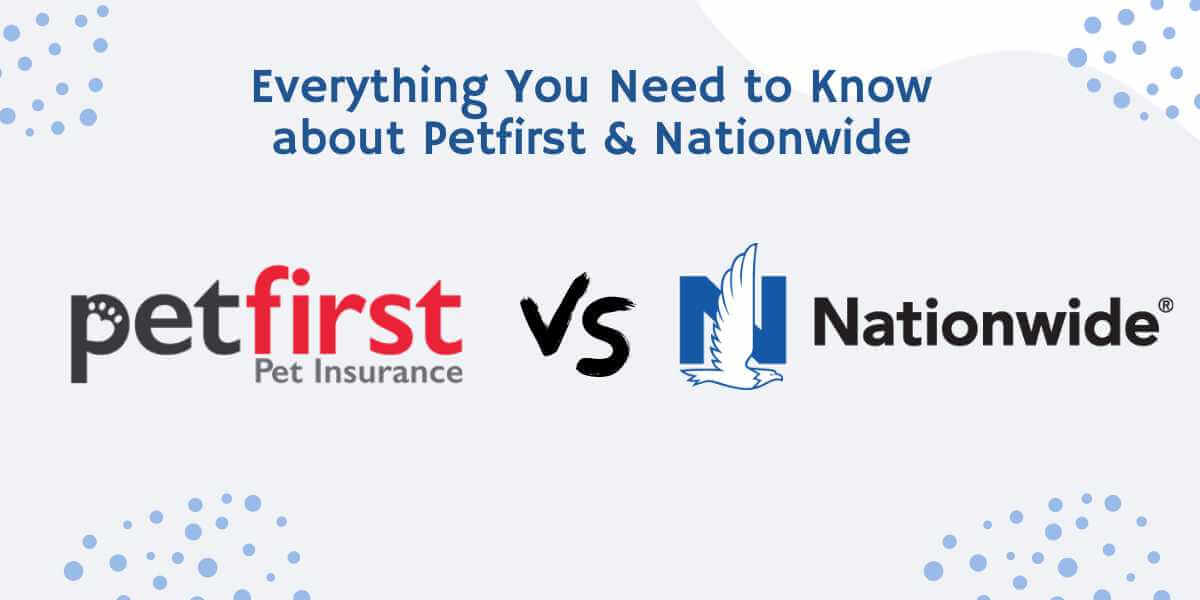Owning a pet comes with a lot of joy and fulfillment, but it also brings significant responsibilities and expenses to many families in the United States.
Every responsible pet parent puts their four-legged friend’s health in the first place and wants to take care of the animal’s recovery process, without the financial burden or rising stress levels.
Naturally, the best solution for this issue is to purchase a pet insurance policy – not by any provider, but by those that provide best-in-class conditions. In this article, we will compare PetFirst and Nationwide as two of the most acclaimed competitors in the pet insurance industry.
Comparing PetFirst vs Nationwide Pet Insurance
A top-notch competitor in the pet insurance field since 2004, PetFirst has been underwritten by MetLife. The company is top-rated with the BBB and praised for the quality of its designated services. However, some PetFirst pet insurance plans may cost you more than those of other competitors, especially when it comes to their per-incident deductibles and coverage limits.
In comparison, Nationwide is a famous pet health insurance provider for people that first added insurance cover for dogs, cats, and other pets in its services in 1982. This company has a simple pricing system that includes a wide range of accidents and illnesses as well as pet wellness coverage expenses.
PetFirst Coverage Details
As a part of MetLife Pet Insurance, PetFirst offers basic accident and pet illness health insurance for cats and dogs via a customizable plan builder. You can use this to create a package aligned with your individual needs and budget.
First, you enter the basic information about your pet, then you can choose a plan with a specific monthly premium payment. This plan decides your annual deductible, annual coverage limit, and reimbursement for your vet bills. PetFirst automatically renews your coverage policy every year so that you don’t need to requalify, and the premium will increase as your pet ages.
PetFirst has quite a short waiting period – 24 hours for accidents and 14 days for illnesses. All claim filing done before the waiting period are considered pre-existing conditions and will be denied. Downgrading coverage comes with no waiting period. However, if you want to upgrade your pet insurance plan – you will have to wait for 14 days.
Apart from accidents and illnesses, PetFirst insurance also includes:
- Diagnostic tests
- X-rays
- Exam fees
- Medications
- Ultrasounds
- Hospitalizations and surgeries
- Emergency care
- Hereditary, congenital, and chronic conditions
- Alternative therapy and holistic care
After the 6-month period passes, you can also acquire insurance cover for ligament diseases such as medial cruciate, anterior cruciate, posterior cruciate, and intervertebral disc disease.
Nationwide Coverage Details
In its essence, Nationwide has three main pet health insurance plans: the Whole Pet plan, the Major Medical plan, and Pet Wellness.
- Whole Pet – this is the provider’s most comprehensive plan that covers the widest range of accidents and injuries. Apart from reimbursing a percentage of your vet bill for accidents and illnesses, it also has you covered with tests and exams. However, this plan excludes routine exams, heartworm prevention, and other wellness expenses.
- Major Medical – the Major Medical plan is based on a benefit schedule that determines the maximum annual reimbursement for a particular condition. This amount is fixed and doesn’t change depending on what your vet charges you. While this plan is generally a less pricey option than the Whole Pet policy, it offers less coverage. For instance, unlike the Whole Pet plan, the Major Medical plan won’t get you covered with the expenses connected to congenital conditions.
- Pet Wellness – with the Pet Wellness plan, Nationwide covers your costs connected to pet vaccinations, nail trimming, heartworm tests, and other routine care procedures. Spay or neuter surgery isn’t included, though.
You can choose between the Wellness Basic plan, coming at a price of $12 to $18 a month with a maximum annual limit of up to $400, and the Wellness Plus plan, available at a monthly premium of $17 to $22 and an annual limit at $500.
Bear in mind that wellness plans aren’t available in all states. In places where they are available, you can opt for a wellness coverage plan on its own or combine it with a Major Medical plan. But, you can’t merge the wellness option with a Whole Pet plan.
PetFirst vs Nationwide: Benefit Limits and Plan Exclusions
As it goes with most pet insurance providers, PetFirst insurance doesn’t include any expenses linked to pet pre-existing conditions. On the other hand, it does cover vet bills connected to congenital and hereditary conditions.
Here’s a list of issues excluded from PetFirst’s insurance policies:
- Pet food, vitamins, mineral supplements, or any special diet products
- Grooming or medicated baths
- Breeding, pregnancy, and all related conditions
- Parasite prevention and treatment
- Behavior training
- Preventative wellness and routine care
- Organ transplant
- Anal gland expression
- Injuries caused by organized fighting, racing, coursing, or commercial guarding
- Elective procedures
As for Nationwide, the pet insurance provider’s policies don’t include:
- Grooming, dental cleaning, and spaying or pet neutering procedures
- Experimental treatments
- Preventative care and wellness procedures (except if you opted for a wellness plan)
- Pre-existing conditions
- Cruciate ligament problems (in the first year of coverage)
In addition to that, Nationwide’s Major Medical plan excludes congenital, developmental as well as some hereditary conditions, several dental diseases, age-related issues with the pet’s hearing and vision, parasite treatment, pet food, or prescribed diet supplements, and behavioral therapy. Breeding or pregnancy are also excluded together alongside all related procedures.
PetFirst vs Nationwide: Deductibles Compared
PetFirst allows you to customize your annual limit, your deductible, and the maximum annual coverage of your plan. Pet parents are also able to choose the percentage of coverage for each kind of expense, with rates varying from 65% to 100%.
When it comes to Nationwide, you can get an annual deductible of $250 for both the Whole Pet and the Major Medical Plan.
PetFirst vs Nationwide: Reimbursement Compared
PetFirst’s average pet insurance plan for both cats and dogs comes with a 90% reimbursement rate.
As for Nationwide, the main difference is in whether you’ll choose their Whole Pet plan or their Major Medical plan. With the Whole Pet plan, you can choose to be reimbursed either 50% or 70% of your vet bills. On the other hand, reimbursement in the Major Medical plan isn’t fixed – it rather depends on your schedule of benefits.
Pricing: Pet First vs Nationwide
One of the main features that make PetFirst stand out from other pet insurance providers is the customizable and transparent pricing. Pet owners can choose coverage options that fit their needs and budget via the user-friendly online tool, so you won’t need to call or email for a quote.
By choosing a family plan that contains multiple pet insurance policies, you can save on premium costs. PetFirst also offers a discount of $25 off your yearly deductible for every year your pet spends without any claim filing.
Let’s take a male domestic shorthair cat under one year of age and a one-year-old mixed-breed dog. For the former, you’d pay $12.35 and get a $500 deductible, a 90% reimbursement rate, and a $5,000 annual benefit maximum. For the latter, you’ll have to pay a $23.19 monthly premium under the same circumstances.
Nationwide, on the other hand, offers different prices for its various insurance plans. When it comes to the Whole Pet Wellness plan, the monthly premium for a one-year-old domestic shorthair cat is $35.45, while an owner of a one-year-old mixed-breed female dog would pay $60.52 per month. Both prices include a $10,000 annual limit and a $250 annual deductible.
Naturally, the cost of your pet insurance plan depends on your pet’s species, age, and overall health. The price of the Whole Pet Wellness plan is also impacted by your chosen reimbursement rate. Therefore, your monthly premium can vary from $15 to $35 if you’re a cat owner and $25 to $60 if you’re a dog owner.
Nationwide also offers additional wellness plans for pet owners who can purchase them on their own or combined with medical coverage. Depending on the reimbursement level, the monthly price of these plans can range from $12 to $22.
Passionate animal lovers with multiple pets can get a discount from Nationwide – more specifically, 5% for two or three pets and 10% for four or more pets living in the same household. The provider also offers a 5% discount for group insurance obtained via employer benefits.
Enrollment Process and Waiting Periods: PetFirst vs Nationwide
PetFirst’s waiting periods are relatively short – 24 hours for accident-related injuries and 14 days for diseases. Even if the particular condition is included in the policy, claims submitted before or during this period would be considered pre-existing conditions and will be excluded from the coverage. You are supposed to wait another 14 days for any upgrades to your coverage, but when it comes to downgrades – there is no waiting period.
With Nationwide’s Whole Pet or Major Medical policy (which you can combine with a wellness plan), pet parents have to wait for 14 days after the purchase. If you choose to purchase a wellness plan on its own, the waiting period is merely 24 hours. When it comes to cruciate ligament issues, the waiting period is 12 months.
Nationwide vs PetFirst: Claims and Service
With PetFirst’s pet insurance, you can file a pet insurance claim after you get the vet bill by email, postal mail, fax, or on the provider’s official website. You need to include a claim form, your vet’s notes about the issue, and the vet’s itemized invoice in your claim. At your initial claim submission, you are also required to disclose 12 months of veterinary records.
You can reach PetFirst’s customer service by phone, email, postal mail, fax, or live chat on the provider’s website. The company’s support team is available every day and you can also contact them on social media such as Twitter, Instagram, and Facebook.
When it comes to Nationwide, you can file your claims online or download a form to send it by email, postal mail, or fax. This provider processes claims in the span of 30 days.
Reimbursement is available electronically and by paper check.
Nationwide’s official website is generally user-friendly and includes all information and answers to FAQs, as well as the online claim submission and policy purchase process. In addition to that, Nationwide has a Smartphone app for all insurance policies it offers. However, the app’s functionality for pet insurance users has limited functionality – it only directs visitors to the website for filing claims.
On the other hand, Nationwide’s pet healthcare coverage policyholders get free access to the VetHelpline app, where you can get in touch with veterinarians who offer advice and consultations.
Alternative options
We have also compared PetFirst with some other brands like ASPCA, DODO and Embrace. You can check those articles as well. It will help you in making a sound decision.
Which One Is Better?
To conclude, PetFirst’s premium costs are lower – starting at $8.35 per month for deductibles of $50, $100, $250, or $500, while also offering military and animal welfare worker discounts. Nationwide’s premiums, on the other hand, start at $16.51 per month for annual deductibles of $100 or $250.
However, despite the higher prices, Nationwide has no enrollment process fee, offers plans for birds and exotic pets, too, and has more comprehensive plans overall – which makes this provider the better choice for your pet.




